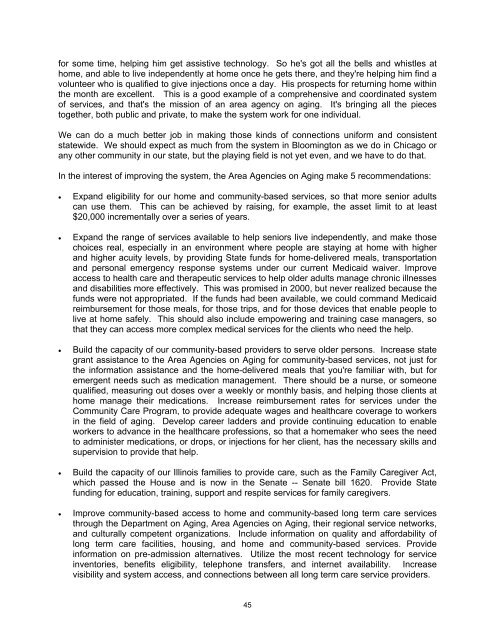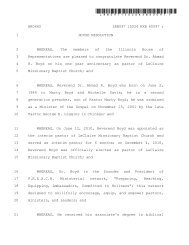Long-Term Care - Illinois General Assembly
Long-Term Care - Illinois General Assembly
Long-Term Care - Illinois General Assembly
You also want an ePaper? Increase the reach of your titles
YUMPU automatically turns print PDFs into web optimized ePapers that Google loves.
for some time, helping him get assistive technology. So he's got all the bells and whistles at<br />
home, and able to live independently at home once he gets there, and they're helping him find a<br />
volunteer who is qualified to give injections once a day. His prospects for returning home within<br />
the month are excellent. This is a good example of a comprehensive and coordinated system<br />
of services, and that's the mission of an area agency on aging. It's bringing all the pieces<br />
together, both public and private, to make the system work for one individual.<br />
We can do a much better job in making those kinds of connections uniform and consistent<br />
statewide. We should expect as much from the system in Bloomington as we do in Chicago or<br />
any other community in our state, but the playing field is not yet even, and we have to do that.<br />
In the interest of improving the system, the Area Agencies on Aging make 5 recommendations:<br />
• Expand eligibility for our home and community-based services, so that more senior adults<br />
can use them. This can be achieved by raising, for example, the asset limit to at least<br />
$20,000 incrementally over a series of years.<br />
• Expand the range of services available to help seniors live independently, and make those<br />
choices real, especially in an environment where people are staying at home with higher<br />
and higher acuity levels, by providing State funds for home-delivered meals, transportation<br />
and personal emergency response systems under our current Medicaid waiver. Improve<br />
access to health care and therapeutic services to help older adults manage chronic illnesses<br />
and disabilities more effectively. This was promised in 2000, but never realized because the<br />
funds were not appropriated. If the funds had been available, we could command Medicaid<br />
reimbursement for those meals, for those trips, and for those devices that enable people to<br />
live at home safely. This should also include empowering and training case managers, so<br />
that they can access more complex medical services for the clients who need the help.<br />
• Build the capacity of our community-based providers to serve older persons. Increase state<br />
grant assistance to the Area Agencies on Aging for community-based services, not just for<br />
the information assistance and the home-delivered meals that you're familiar with, but for<br />
emergent needs such as medication management. There should be a nurse, or someone<br />
qualified, measuring out doses over a weekly or monthly basis, and helping those clients at<br />
home manage their medications. Increase reimbursement rates for services under the<br />
Community <strong>Care</strong> Program, to provide adequate wages and healthcare coverage to workers<br />
in the field of aging. Develop career ladders and provide continuing education to enable<br />
workers to advance in the healthcare professions, so that a homemaker who sees the need<br />
to administer medications, or drops, or injections for her client, has the necessary skills and<br />
supervision to provide that help.<br />
• Build the capacity of our <strong>Illinois</strong> families to provide care, such as the Family <strong>Care</strong>giver Act,<br />
which passed the House and is now in the Senate -- Senate bill 1620. Provide State<br />
funding for education, training, support and respite services for family caregivers.<br />
• Improve community-based access to home and community-based long term care services<br />
through the Department on Aging, Area Agencies on Aging, their regional service networks,<br />
and culturally competent organizations. Include information on quality and affordability of<br />
long term care facilities, housing, and home and community-based services. Provide<br />
information on pre-admission alternatives. Utilize the most recent technology for service<br />
inventories, benefits eligibility, telephone transfers, and internet availability. Increase<br />
visibility and system access, and connections between all long term care service providers.<br />
45
















